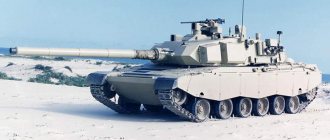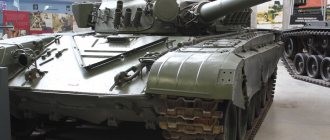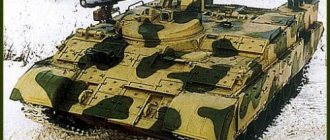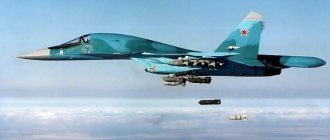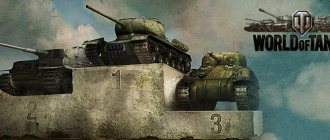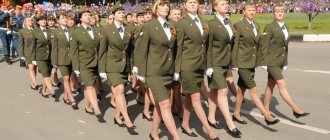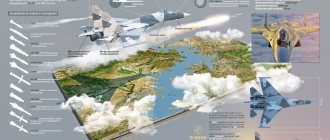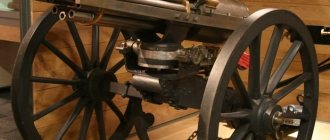Armata T-14
Active protection complex "Afganit"
But armor cannot 100% protect a tank from modern anti-tank weapons, so the T-14 is equipped with the Afghanit active protection complex, which has the ability to intercept modern ATGMs, cumulative grenades from RPGs, as well as sub-caliber armor-piercing shells while approaching the tank.
Defense Update experts , when analyzing the Afghanit system on the T-14, indicate that it consists of damaging and camouflage elements. The striking elements are located in shotgun pedestals under the turret, which operate similarly to the Drozd KAZ, but more efficiently - the reaction time allows you to intercept even sub-caliber shells. The Afghanit developers also received patent RU 2263268 for an active protection system based on the “shock core” principle, which allows them to shoot down promising ammunition at speeds of up to 3000 m/s.
The camouflage elements of the Afghanit active protection complex are located in small mortars on the roof of the tank turret. Defense Update experts report that, presumably, the camouflage elements operate simultaneously as: a smoke screen, a multispectral curtain (including the IR range) and a curtain opaque to millimeter-wave radars (by releasing a cloud of miniature dipoles). According to Defense Update, this completely blocks anti-tank systems built on the principle of laser (ATGM Hellfire, TOW, Fagot, Skif, Stugna-P), IR guidance (ATGM Javelin, Spike) and with their own MW radar (ATGM JAGM, Brimstone) , making Armata protected from these anti-tank missiles, as well as from gliding homing charges (“roofbreakers”).
To counteract guidance radars and AWACS aircraft, the T-14 tank uses modern elements of stealth technology with characteristic flat edges (see, for example, the casing on the turret of the Armata tank). Defense Update experts indicate that the combined destructive and camouflage KAZ "Afganit" is triggered by an AFAR radar, which is divided into 4 separate matrices directed in different directions, the rear matrices are turned upward to control the upper hemisphere, so the AFAR radar has circular coverage. The tank's optical surveillance equipment is also integrated with a system for proactive delivery of curtains.
Previously, the developers of the T-14 also reported that the machine gun mount, based on data from the AFAR radar, is capable of protecting the tank not only by shooting down incoming anti-tank missiles, but also having a significant probability of hitting anti-tank shells in order to change the flight path of sub-caliber shells or damage cumulative ammunition.
The final version of the T-14 "Armata" with a half-disassembled turret is shown
Hello everyone, just the other day during the visit of Deputy Minister of Defense of the Russian Federation Alexei Krivoruchko to UVZ, they partially demonstrated the stages of assembly of the T-14 MBT on the unified Armata platform, and it would seem that what new can be learned from this? Let's figure it out. The first prototypes of the T-14 MBT were demonstrated to the general public in 2015 at the Victory Parade, and after that it was announced that up to 2000 MBTs could be supplied to the troops, but something went wrong, according to the liberal-minded audience. In the entire history of tank building, never a new MBT, practically a prototype, was put into service immediately after a demonstration; the vehicle was sent for testing, during which shortcomings and comments were identified, but eliminating them could take years, say from 2 to 5 years.
The final appearance of the T-14 "Armata" MBT of the 2022 model. / Photo source: Yandex.Images
Actually, this is what happened with the T-14, since this is a completely new tank created from scratch, and even the first tank with an uninhabited turret brought to fruition, it was stupid to believe that problems would bypass the vehicle. The first drawback was the engine, it is extremely complex since it is X-shaped and no one in the world has been able to implement a control system of such a layout before mass production; at first it was even supposed to install an engine from the T90M, but still the engineers were able to finish the X-shaped 12 The three-cylinder A-85-3A and MBT received the planned MTO. Earlier in one of the articles, I wrote about the fact that at the Army-2021 forum the T-14 was shown with some modifications, namely, a 7.62 mm coaxial machine gun, other KAZ side modules, as well as a different shape and roller diameter.
Track rollers T-14, new and old version. / Photo source: Yandex.Images
This time, UVZ essentially demonstrated the final version, which will go straight from the factory to the troops and the first batch will amount to 20 vehicles by the beginning of 2022.
Please note: Is it worth buying Object 703 Option II in the Holiday Calendar in WoT? Last lot in 2022.
So what else has changed in the T-14? First, let's take a look at the tower without protective panels, here we see a scattering of equipment, most of which belongs to KAZ and KOEP, as well as niches for control system equipment. You can also see that the engineering hatch on the roof is open, and there are automatic loader trays nearby. In addition, the rear part has also undergone minor changes; the location of the transport hooks has changed. However, the most significant changes were in the frontal part of the tank. T-14 MBT without side panels and with a semi-disassembled turret. / Photo source: Yandex.Images
You can notice that the angle of inclination and the VLD itself differs in shape and thickness, the tank’s armor has been increased, most likely this is due to the emergence of a new 130 mm tank gun among NATO countries with a declared armor penetration of at least 1 meter of homogeneous armor steel, and a year ago they even showed a prototype MBT based on Leopard-2 with such a gun, and at the same time the prototype could perfectly fire at targets.
Changes in the platform design 2015 - 2022. / Photo source: Yandex.Images
The RF Ministry of Defense and UVZ most likely took this factor into account and modified the T-14, in addition to strengthening the VLD, the side panels with remote sensing also changed, because of this, the front part of the panel changed its shape and thickness, the design of the NLD in the upper part also changed, it became thicker , and the dump that was previously divided became solid.
MBT T-14 model 2021 without turret “casings” and the main sight. / Photo source: Yandex.Images
Let's summarize: the T-14 MBT project does not stand still and, despite the delay in deliveries to the troops, it is being modernized and improved, losing its “childish” sores, the number of complaints about the vehicle is less and less, and the T-14 itself is acquiring its final appearance and technical appearance, turning from a prototype into a serial and combat-ready solution, which essentially has no analogues in the world, no matter how “vapid” it may sound. And that’s all for today, bye everyone, thank you for your attention and subscribe to the section.
For those who have been familiar with the channel for a long time, I inform you that in December there will be an article about how I will assemble and test a home PC based on the Elbrus processor, negotiations with MCST are at the final stage, so don’t miss it, it will be interesting.
#t14 #Armata tank #UVS #tanks #weapons #army #technology #equipment #Russia #armored vehicles
More interesting articles here: History.
Source of the article: The final version of the T-14 "Armata" with a half-disassembled turret is shown.
- Previous: A World War II tank was pulled out from under 4.5 thousand tons of soil
- Next: The German column was defeated and important documents were captured. A short adventure of tanker Lavrinenko on the outskirts of Serpukhov
Bottom line
The tank was and remains the most well-protected vehicle on the battlefield. No matter what some experts say, there is no replacement for them and there is no sign of them in the foreseeable future.
The Armata platform is needed at a minimum as an important image project for the country and a “field laboratory” with the help of which the appearance of the ground forces of the future will be determined.
As for saving, it is appropriate to recall the well-known saying “the miser pays twice.” At the current pace of development of technology and weapons, those who are too economical have a chance to fall behind for decades, if not forever. In this case, you will be very lucky if you can pay for the backlog with money, and not with the blood of your soldiers.
Can I see everyone?
The war of the future has been dealt with. Now we need to consider the most likely candidates for the “tanks of the future.” Of course, we are not considering the “tanks are not needed” option: it’s 2018, and there are almost no adherents of this point of view left, except perhaps the most mossy ones. The last decade has shown that experts with similar views are not needed.
Option 1 (belt tightening)
The Army continues to modernize the T-72. There will be no new tanks, maximum overhaul and modernization. The option is very tempting from a financial point of view.
Shortly before the start of Army 2018, Deputy Prime Minister Yuri Borisov, who oversees the defense industry, told reporters: “Armata” is too expensive.
“Why “flood” all the armed forces with “Armatians” or “Boomerangs”? Our T-72 tank is in great demand on the market, everyone takes it. Compared to the Abrams, Leclercs and Leopards, it is significantly superior in price, efficiency and quality.”
Cheap and cheerful, but with the public demonstration of the Armata, Russia stirred up a hornet’s nest.
Already in 2016, the Rheinmetall concern showed a prototype of a 130-mm tank gun. In June 2018, France and Germany presented a joint demonstrator tank at the Eurosatorium (wits immediately dubbed it the Leoclerc, since it was a Leclerc turret on a Leopard chassis). The Americans have seriously taken up the KAZ and the next upgrade of the Abrams. Work has intensified in Israel, Great Britain, Sweden and other countries.
Concept hybrid of “Leopard” and “Leclerc”
You can’t turn the mincemeat back; abandoning the Armata means falling behind the enemy for decades and forever losing your reputation and export markets. Saving now will cost you dearly in the future.
Anton Zheleznyak Technical and engineering expert
Remember the story with the purchase of the BMPT-72 “Terminator”? The main reason for purchasing this, frankly speaking, exotic car is to once and for all get rid of awkward questions like “why are you selling us a car that you don’t use yourself - is there something wrong with it?” It’s the same with the Armata - without the tank being put into service in Russia, not a single foreign army will buy it.
Option 2 (compromise)
The army is upgrading the T-72 to the T-72B3 and purchasing the T-90 as its main one. For example, in the T-90M version (at Army 2018 it became known that the Ministry of Defense will purchase a second battalion set of T-90M tanks).
It would seem that this is an ideal option that both the military and financiers will rejoice at. But this path will only delay the inevitable - the transition to new cars.
As excellent as the T-72 tank and its newest incarnation, the T-90M, are, the possibilities for modernization are not endless.
A tanker's workplace in an armored capsule "Armata" (but nowhere without a small sapper shovel in the 21st century)
The T-72 is a simple, reliable tank, mastered by production. But it was created for another war - a global one, with losses comparable to 1941. The Soviet leadership was “traumatized” by the blitzkrieg, so they were constantly afraid that there would not be enough tanks. In the foreseeable future, such a large-scale war is unlikely. But others are likely - where it is impossible to do without promising combat platforms.
When comparing the T-14 and T-72 in size, they forget that the crew in the Armata hides much lower (all three are in the capsule, and in the T-72 two are in the turret)
At the same time, there is a non-zero chance of finding yourself in a situation where a new car is needed “yesterday”, and time and money are spent on compromise options. In the most unpleasant scenario, industry will have to frantically master mass production, and the military will have to put up with inevitable shortcomings that did not “surface” in a calmer environment. Yes, just like in 1940–1941, when a qualitative leap was made from the mass-produced light T-26 and BT-7 to the medium T-34.
Option 3 (real)
The Army is upgrading the T-72 and T-80 to the T-72B3 (or B3M) and T-80BVM variants. At the same time, new T-90M (better than T-90MS, but we have what we have) and T-14 are being purchased. The option - what can we hide - is the most expensive, but also the most logical.
T-14 "Armata" and T-72B3
There are several advantages here. First, quiet military operation in peacetime will reveal shortcomings that will be resolved in the future. It will allow you to try out new tactics and a new organizational structure.
Secondly, the number of specialists familiar with the new technology will increase in the army and in production. Still, without a trained crew or technicians, even the most modern tank is a pile of iron.
The unification of technology also plays an important role. The current “vinaigrette” with three (or more, if you count deep modernizations) types of MBT, to put it mildly, is unpleasant both from the point of view of application and from the point of view of support.
Quite ancient machines will be replaced from storage bases by completely modern modifications. For example, in the army the T-14 will replace the T-72B3, and in storage the T-72B3 will replace the “grandfathers” T-62, which will find a place, for example, in the Middle East.
"Armata" has arrived: Tanks tested in Syria can roll across Ukraine
Rostec presented the military with a luxurious gift for the New Year - the state corporation announced the launch of mass production at Uralvagonzavod of the T-14 tank on the Armata platform. The event is called a “breakthrough project” for the supply of the Ministry of Defense. Initially, in 2015, there was talk of producing 2,300 such combat vehicles, now, judging by the statement about approaching 100% fulfillment of the State Defense Order, there are more than a hundred of them in the troops (more precisely, about 130).
The very fact of launching the T-14 tank into mass production speaks volumes. This means that the requirements of the customer, represented by the Ministry of Defense, have been met to eliminate the identified deficiencies that related to the engine and weapons. "Armata" received an A-85−3A engine with a power of 1500 hp. with the possibility of boosting it to 1800 hp, a reinforced transmission, a 2A82 smoothbore gun with a 125-mm caliber, which can be replaced by a 152-mm 2A83 upon request. In addition, the T-14 is capable of launching the Pterodactyl onboard unmanned reconnaissance and target designation vehicle with a surveillance radar and an infrared sight. The security of this tank has also been strengthened, and also, sorry, a bathroom for the crew was installed in the Armata, probably a dry closet.
What do you want to do for now, wealthy moles? - What if we count?
“Lieutenant, what about the money?” many critics of the project ask. Indeed, the T-14 costs a lot. Back in 2016, UVZ set the cost of the T-14 Armata at 250 million rubles, that is, around $3.7 million.
Is it expensive? Yes and no.
Firstly, this is the price of an experimental machine. According to the developers, in the series the cost of the T-14 will drop by at least a quarter. Of course, upgrading the T-72 to B3 is several times cheaper (from 52 million rubles, according to open sources), but an updated old vehicle will almost always be cheaper than a new one.
At the same time, a brand new Leopard 2A7V costs $8.5 million. The American Abrams M1A2 costs nine million dollars, and the package of its improvements to the SEPv3 version costs about another three million dollars. The cost of the South Korean K2 is about $8.5 million, the British Challenger 2 is about $5.4 million.
Challenger 2 tank with TES kit (photo: Vitaly Kuzmin)
In principle, any modern military equipment - thanks to new technologies and electronics - is not cheap, and will only become more expensive. But since we agreed that we no longer need tank hordes of thousands, then this is a completely acceptable price for new generation combat vehicles.
Armata platform and its engine
The main tank T-14 on the Armata platform. Photo by NPK UVZ
Three models of military equipment for various purposes have already been created on the basis of the Armata universal tracked platform, and new unified vehicles may appear in the future. Existing and expected projects use a number of unified units and systems, incl. power point. The latter was created specifically for the Armata platform and should ensure the achievement of high technical characteristics.
Platform and its engine
The development program for a promising platform and armored vehicles based on it was launched in mid-2011. The main design work took several years, and already in May 2015 the first open display of armored vehicles from a pilot production batch took place.
During the same period, a long process of testing, refinement and preparation for a full-scale series began. The basic Armata platform was equipped with a unified power plant based on modern units. Its parameters were selected taking into account the need to ensure high mobility characteristics of various equipment with different layouts and combat weights. Depending on the design features of the armored vehicle, the power plant can be located in the bow or stern of the hull.
Diesel engine V-92, used on the T-90 tank. Photo "ChTZ-Uraltrak"
The power plant of the "Armata" is based on the 12N360 engine (also known as the designations A-85-3A and 2B-12-3A), produced by the Chelyabinsk Tractor Plant. Interestingly, the engine is several years older than the universal platform. According to some reports, such an engine was created for the promising Object 195 tank, but this project did not advance beyond testing.
In the 2000s, the development organization began to openly display the new engine at military-technical and industrial exhibitions. At that time, the direct connection of this product with the tank industry was not confirmed. The 12N360 was positioned as a motor for special-purpose vehicles and equipment in the oil and gas industry.
Later it became known about the use of the A-85-3A in the project of a promising armored platform. Such engines were to be used on all models of the family and provide high energy parameters - regardless of purpose, layout, combat weight, etc.
New solutions
The 12N360 engine has 12 cylinders and is built in an X-shaped design, which makes it possible to reduce dimensions and weight. The length of the product is 900 mm with a width of 1.8 m and a height of 830 mm. Dry weight - 1.5 tons. Thus, the new engine is more compact, but heavier than previous V-shaped tank engines, such as the B-92.
Engine for special machines and installations 12N360. Photo Gurkhan.blogspot.com
The engine is four-stroke and can use different types of liquid fuel. Cylinders with a total volume of approx. 35 l have a direct injection system. Turbocharging is used in the form of two gas turbine superchargers, serving half the cylinders each. Cooling of the cylinder block is liquid. There is intermediate cooling of the charge air.
The 12N360 engine initially had variable maximum power. The first modification, depending on the mode, could produce from 800 to 1500 hp. at 1800-2100 rpm. Subsequently, plans were announced to boost the engine to reach 1800 hp. and maintaining the speed at the same level.
Thus, when installed on vehicles of the Armata family with a combat weight of 50 tons, the A-85-3A engine provides a specific power from 16 to 36 hp. per ton. The optimal value for this parameter is considered to be 25 hp. per ton, and the new engine retains a serious reserve of characteristics for further upgrades.
12N360 at a later exhibition. Photo "ChTZ-Uraltrak"
The engine is coupled with a mechanical transmission with robotic gear shifting. Its main unit is a central gearbox with built-in reverse. The box has 8 gears, and reverse allows you to use them when moving forward and backward. Thus, 16 forward and reverse speeds are actually provided.
The engine, transmission and other components of the power plant are made in the form of a single unit, fixed in the engine-transmission compartment of an MBT or other armored vehicle. In the event of a breakdown, it is possible to remove the entire unit and install a new one. These procedures, when using a repair and recovery vehicle, take about half an hour.
Advantages of being new
Due to the new power plant, the unified Armata platform has significant advantages over armored vehicles of older models - both in terms of basic technical characteristics and in terms of project development and subsequent operation.
View from a different angle. Photo Vpk.name
First of all, it should be recalled that for the first time domestic armored vehicles will receive 1500 hp engines. or more. This will give an obvious increase in mobility and cross-country ability, and will also affect overall efficiency. At the same time, specific power and specific fuel consumption have improved compared to older diesel engines.
12H360 is more flexible in use. By setting the required maximum power, it can be adapted to the requirements of a specific combat or auxiliary vehicle and obtain the optimal balance of performance. Accordingly, different types of equipment can be equipped with a unified engine, and not only within the same platform.
At the development stage
Over the past few years, various stages of testing of various types of equipment based on the Armata platform have been carried out. It is known that there are a number of main tanks, heavy infantry fighting vehicles and armored vehicles on a common chassis with a unified power plant.
Power block "Armata" assembled. Still from t/p “Military Acceptance”, t/t “Zvezda”
According to known data, sea trials of such equipment take place, in general, without significant difficulties. In the recent past, the Ministry of Defense has repeatedly published spectacular shots of tanks at full speed, equipped with 12N360 engines and other new units. However, as far as is known, during the tests certain features and shortcomings were identified that require correction.
Following the Army-2019 forum, it was reported that the engine is a promising engine for the Armata in terms of efficiency characteristics, heat transfer, service life, etc. inferior to modern foreign models, and this does not suit the military. At that time, it was proposed to consider the possibility of using a different engine. However, there were no further messages about the remotorization of the platform.
Probably, testing of the platform and equipment based on it in the proposed configuration was successfully completed and made it possible to get rid of known shortcomings. This allows us to continue the production of armored vehicles and transfer them to the troops for the next planned events.
Manufactured by "Armat". Still from a report from TV channel “Zvezda”
The Shape of the Future
In the context of power plants for the Armata platform, an interesting situation occurs.
First, a promising engine with an unusual design appeared, and only then did the development of a new family of equipment begin. Then such a motor was modified to meet new needs, combined with a transmission of the required design and included in the unified components of the platform. In the foreseeable future, equipment based on the Armata will be put into service and will begin to enter the troops in significant quantities. In the long term, this platform could even become the basis of the Russian armored vehicle fleet. Along with it, a unified power plant based on the 12N360 engine will become a key component of the army’s materiel. It is obvious that the development of this engine will continue and will lead to the emergence of improved modifications or completely new products.
It is quite possible that the modern 12N360 will eventually become the basis of an entire family - and will occupy the same place in the history of tank building as the legendary B-2 in the past. However, for now, developers of engines and armored vehicles are faced with more mundane tasks. It is necessary to rid the engine of identified deficiencies and bring it to full operation, giving the army new advantages.
